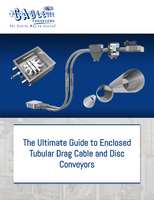seepex NaOCI Metering Pump

The Problem
When Billy Branch, Maintenance Supervisor of the Moores Bridges Water
Treatment Plant in Norfolk Virginia, found that the hydraulic diaphragm metering pumps
the plant used for producing and pumping chloramine were having performance issues,
he solved the problem with seepex progressive cavity pumps. Billy ended up replacing
all of the diaphragm pumps for hypochlorite and aqueous ammonia with seepex PC
pumps.
Several issues stood in the way of the needed level of performance to pump
sodium hypochlorite, or "NaOCI", for the water treatment facility. By design, diaphragm
pumps are very complex and prone to breakdown. Repair kits were too expensive for as
often as the pumps failed, and downtime due to maintenance was excessive. The parts of
the hydraulic diaphragm metering pumps were not service-friendly, and the required
pulsation dampeners did not perform very well. Vapor lock and leakage were other
major issues that needed to be addressed. Frequent, complicated, costly, and labor
intensive repairs were the causing the plant frustrations. The Moores Bridges Plant
concluded that diaphragm pumps were much too costly, and they decided they must go in
a different direction.
The Solution
Stuart Taylor, a sales engineer for the seepex distributor, Tencarva Machinery in
Chesapeake Virginia, recommended progressive cavity metering pumps manufactured by
seepex Inc. When explaining why these pumps were a better choice he said, "The seepex
titanium fitted MD pumps are a tight little package. The pump has long life and the parts are easily changed and reasonably priced. You can save time and money using these
pumps."
Taylor offered Branch a trial titanium pump at no charge. The results of the trial
run were so impressive, the plant decided to go ahead and made the switch to the MD
series of pumps manufactured by seepex. Coincidentally, while ordering a seepex pump,
their old pumps failed again. Branch requested to purchase the trial pump and have it put in-place permanently. Since 2007, the city of Norfolk bought four more seepex pumps to replace a total of 15 diaphragm pumps. At least two of the seepex metering pumps are running at any given time. The models they use are the MD 05-6LT with titanium and EPDM wetted parts. These are designed to aid with operational reliability, increase service life with optimum pump speeds, and to ensure precise metering of the NaOCI being pumped. They have eliminated the need for pulsation dampeners altogether. The gases present when pumping NaOCI do not affect the performance of a seepex pump and it is now easier to regulate the feed of NaOCI over the entire dosing range.
Conclusion
The seepex NaOCI pump turned out to be superior to other previously used
models because the pumps reliable, service-friendly, and in need of less repair which
means less downtime. They offer significant savings because of low operating costs and
fewer personnel are needed to repair them. The pumps are also able to pump against high
pressures without pulsation, will not vapor lock, are protected from run-dry, and over
pressure, optimizing the lifecycle costs of the pump.
Billy Branch, expressed the improvements gained by the use of seepex pumps.
"seepex offered us a simple product that works well. The transition between the old
pumps and the seepex model was easy. The cost savings to the people of Norfolk is
significant."
After switching to seepex progressive cavity pumps for NaOCI pumping, Branch
explored the possibility of using the pumps as a replacement for aqueous ammonia
dosing too. After successful testing, their eight ammonia pumps were replaced with
stainless steel seepex models.
Branch added, "We were in a real bind, and the seepex pumps really saved us a
lot of sleepless nights and maintenance headaches. We went from working on the pumps
daily to just changing oil once a year and not having to worry about them failing." The
Moores Bridges Water Treatment Plant looks forward to purchasing more seepex pumps
in the future.




